MREGC5001 Plant Purchase: Capital Investment Analysis & Replacement
VerifiedAdded on 2023/06/12
|16
|3540
|204
Homework Assignment
AI Summary
This assignment provides a comprehensive analysis of plant purchase, installation, and replacement decisions, utilizing methods such as annual worth, present worth, and internal rate of return (IRR). It includes a detailed evaluation of different automation degrees for a manufacturing process, considering factors like first cost, labor, power, maintenance, and tax implications. The assignment also explores the conventional and modified benefit-cost ratio methods, leasing alternatives, and equivalent annual cost analysis for equipment replacement options. Furthermore, it identifies gaps in the implementation of life cycle costing within ID Engineering Works Limited, offering recommendations for improving the decision-making process by incorporating relevant cost considerations. This document is a student contribution and is available on Desklib, a platform offering a wide array of study resources and AI-powered tools for students.
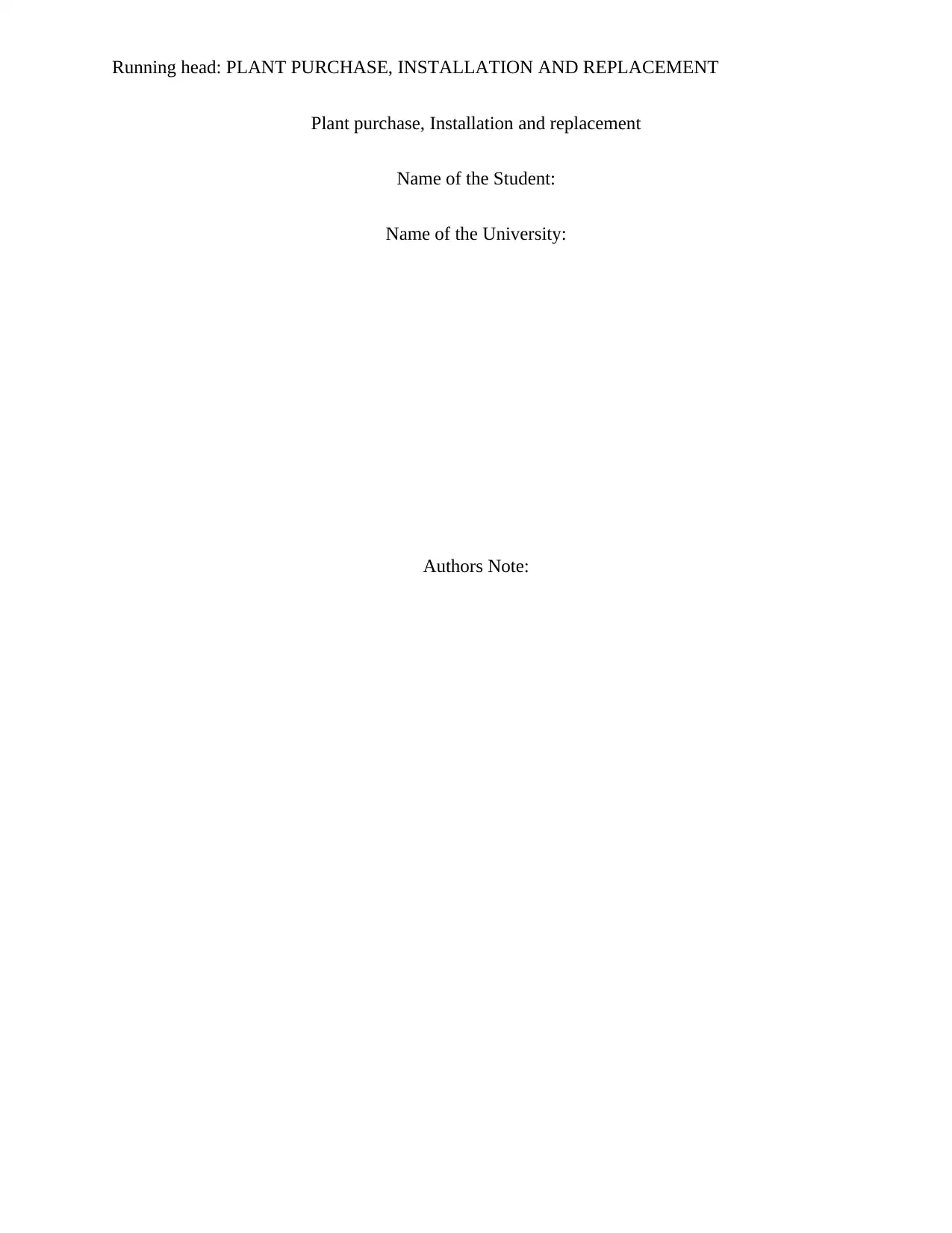
Running head: PLANT PURCHASE, INSTALLATION AND REPLACEMENT
Plant purchase, Installation and replacement
Name of the Student:
Name of the University:
Authors Note:
Plant purchase, Installation and replacement
Name of the Student:
Name of the University:
Authors Note:
Secure Best Marks with AI Grader
Need help grading? Try our AI Grader for instant feedback on your assignments.
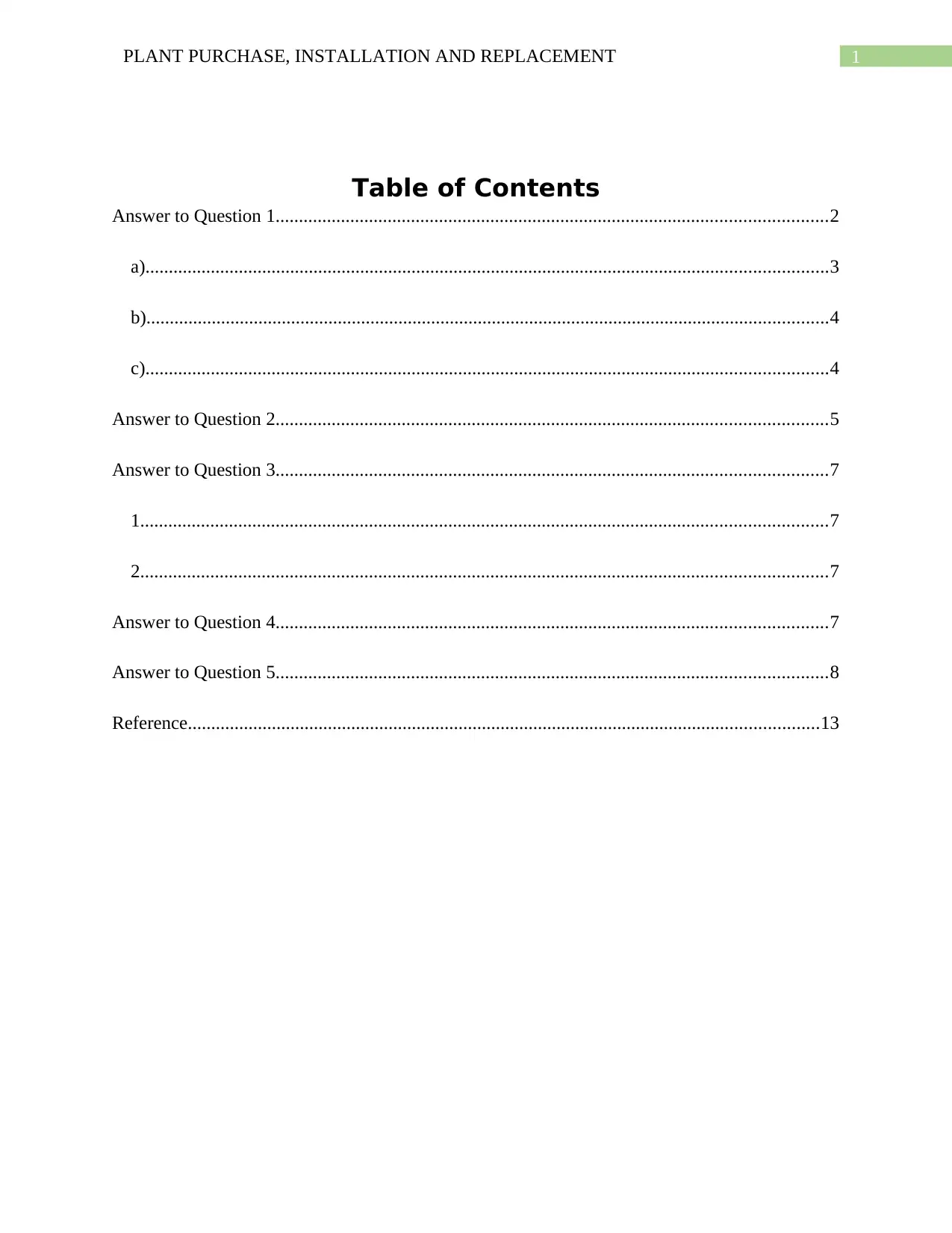
1PLANT PURCHASE, INSTALLATION AND REPLACEMENT
Table of Contents
Answer to Question 1......................................................................................................................2
a)..................................................................................................................................................3
b)..................................................................................................................................................4
c)..................................................................................................................................................4
Answer to Question 2......................................................................................................................5
Answer to Question 3......................................................................................................................7
1...................................................................................................................................................7
2...................................................................................................................................................7
Answer to Question 4......................................................................................................................7
Answer to Question 5......................................................................................................................8
Reference.......................................................................................................................................13
Table of Contents
Answer to Question 1......................................................................................................................2
a)..................................................................................................................................................3
b)..................................................................................................................................................4
c)..................................................................................................................................................4
Answer to Question 2......................................................................................................................5
Answer to Question 3......................................................................................................................7
1...................................................................................................................................................7
2...................................................................................................................................................7
Answer to Question 4......................................................................................................................7
Answer to Question 5......................................................................................................................8
Reference.......................................................................................................................................13
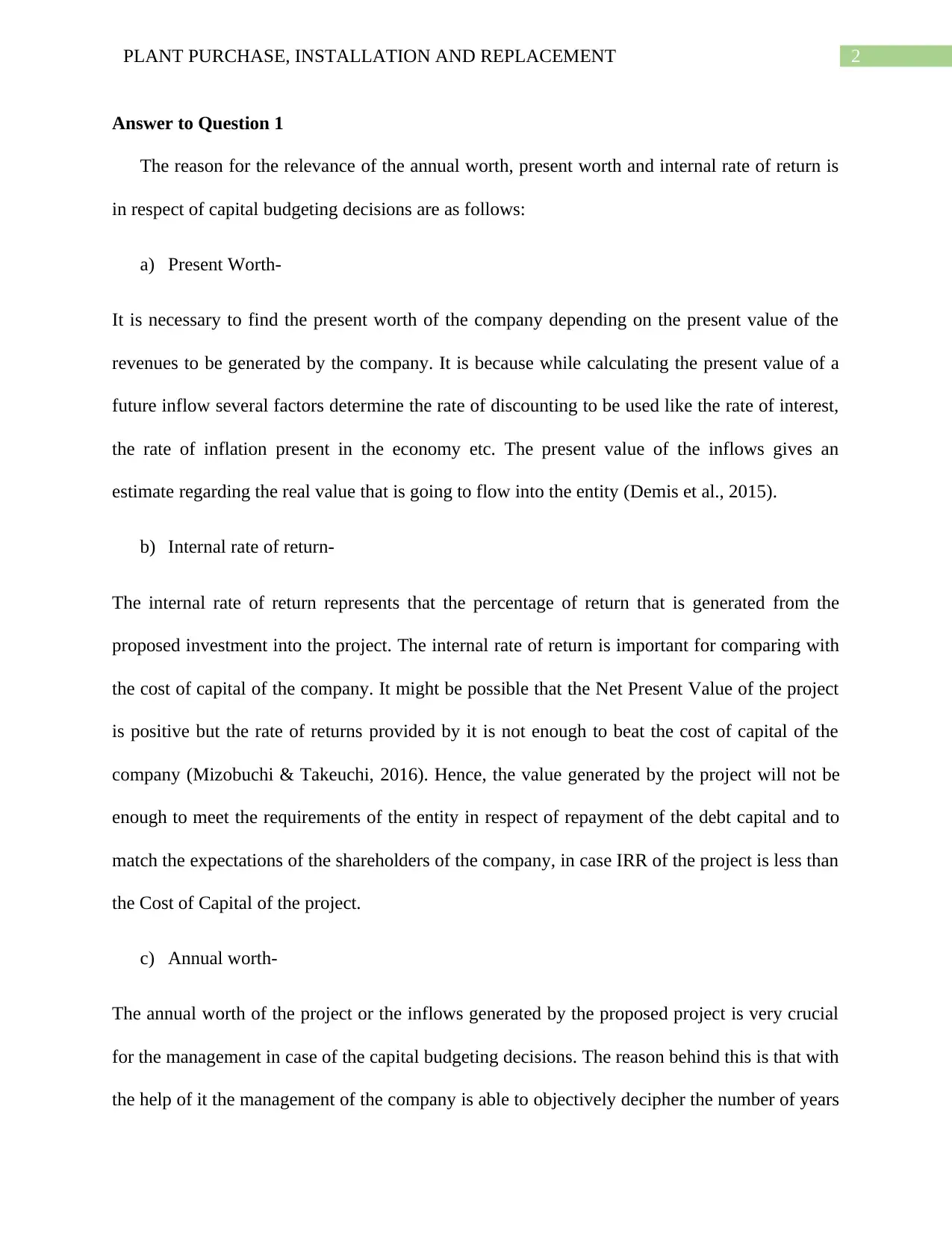
2PLANT PURCHASE, INSTALLATION AND REPLACEMENT
Answer to Question 1
The reason for the relevance of the annual worth, present worth and internal rate of return is
in respect of capital budgeting decisions are as follows:
a) Present Worth-
It is necessary to find the present worth of the company depending on the present value of the
revenues to be generated by the company. It is because while calculating the present value of a
future inflow several factors determine the rate of discounting to be used like the rate of interest,
the rate of inflation present in the economy etc. The present value of the inflows gives an
estimate regarding the real value that is going to flow into the entity (Demis et al., 2015).
b) Internal rate of return-
The internal rate of return represents that the percentage of return that is generated from the
proposed investment into the project. The internal rate of return is important for comparing with
the cost of capital of the company. It might be possible that the Net Present Value of the project
is positive but the rate of returns provided by it is not enough to beat the cost of capital of the
company (Mizobuchi & Takeuchi, 2016). Hence, the value generated by the project will not be
enough to meet the requirements of the entity in respect of repayment of the debt capital and to
match the expectations of the shareholders of the company, in case IRR of the project is less than
the Cost of Capital of the project.
c) Annual worth-
The annual worth of the project or the inflows generated by the proposed project is very crucial
for the management in case of the capital budgeting decisions. The reason behind this is that with
the help of it the management of the company is able to objectively decipher the number of years
Answer to Question 1
The reason for the relevance of the annual worth, present worth and internal rate of return is
in respect of capital budgeting decisions are as follows:
a) Present Worth-
It is necessary to find the present worth of the company depending on the present value of the
revenues to be generated by the company. It is because while calculating the present value of a
future inflow several factors determine the rate of discounting to be used like the rate of interest,
the rate of inflation present in the economy etc. The present value of the inflows gives an
estimate regarding the real value that is going to flow into the entity (Demis et al., 2015).
b) Internal rate of return-
The internal rate of return represents that the percentage of return that is generated from the
proposed investment into the project. The internal rate of return is important for comparing with
the cost of capital of the company. It might be possible that the Net Present Value of the project
is positive but the rate of returns provided by it is not enough to beat the cost of capital of the
company (Mizobuchi & Takeuchi, 2016). Hence, the value generated by the project will not be
enough to meet the requirements of the entity in respect of repayment of the debt capital and to
match the expectations of the shareholders of the company, in case IRR of the project is less than
the Cost of Capital of the project.
c) Annual worth-
The annual worth of the project or the inflows generated by the proposed project is very crucial
for the management in case of the capital budgeting decisions. The reason behind this is that with
the help of it the management of the company is able to objectively decipher the number of years
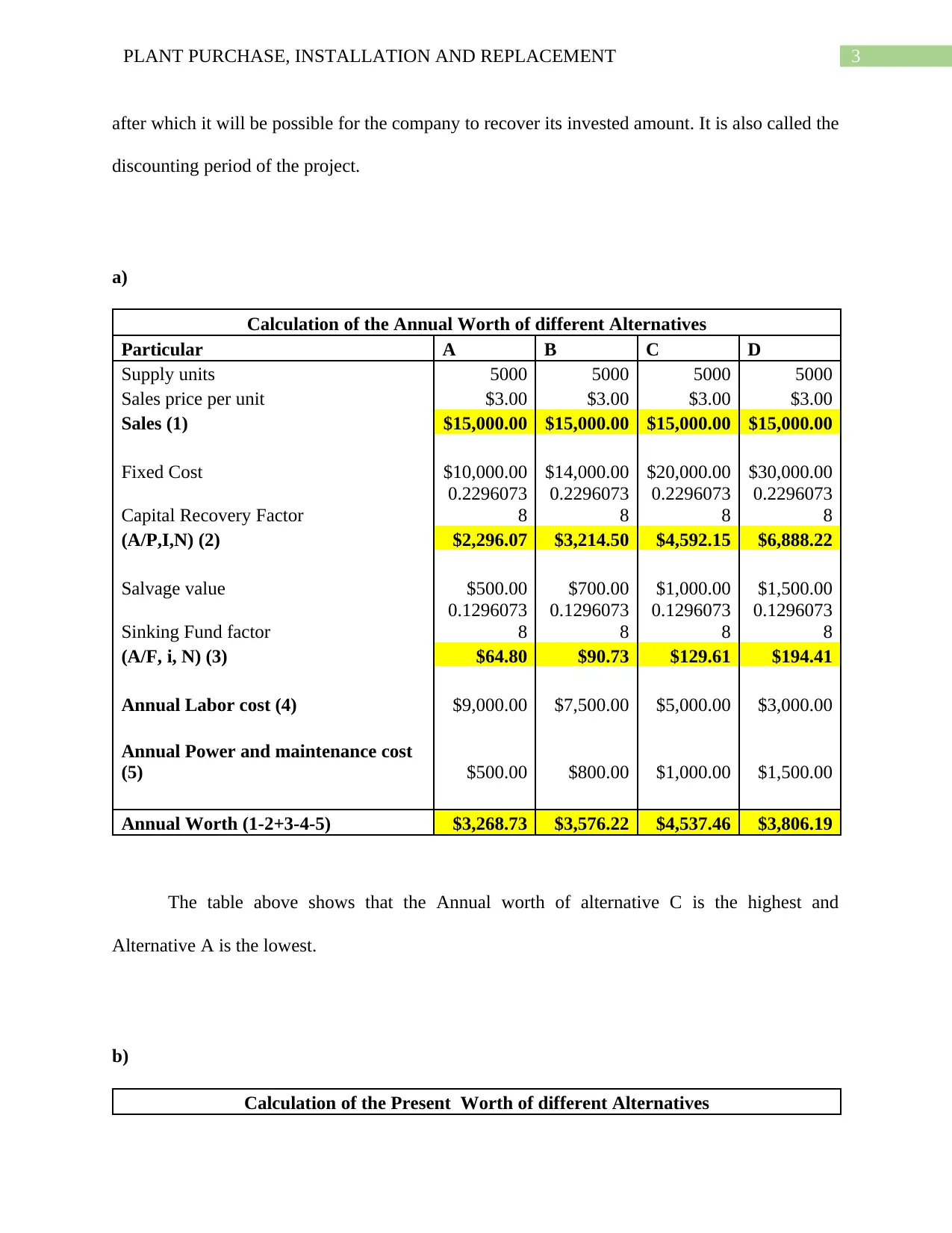
3PLANT PURCHASE, INSTALLATION AND REPLACEMENT
after which it will be possible for the company to recover its invested amount. It is also called the
discounting period of the project.
a)
Calculation of the Annual Worth of different Alternatives
Particular A B C D
Supply units 5000 5000 5000 5000
Sales price per unit $3.00 $3.00 $3.00 $3.00
Sales (1) $15,000.00 $15,000.00 $15,000.00 $15,000.00
Fixed Cost $10,000.00 $14,000.00 $20,000.00 $30,000.00
Capital Recovery Factor
0.2296073
8
0.2296073
8
0.2296073
8
0.2296073
8
(A/P,I,N) (2) $2,296.07 $3,214.50 $4,592.15 $6,888.22
Salvage value $500.00 $700.00 $1,000.00 $1,500.00
Sinking Fund factor
0.1296073
8
0.1296073
8
0.1296073
8
0.1296073
8
(A/F, i, N) (3) $64.80 $90.73 $129.61 $194.41
Annual Labor cost (4) $9,000.00 $7,500.00 $5,000.00 $3,000.00
Annual Power and maintenance cost
(5) $500.00 $800.00 $1,000.00 $1,500.00
Annual Worth (1-2+3-4-5) $3,268.73 $3,576.22 $4,537.46 $3,806.19
The table above shows that the Annual worth of alternative C is the highest and
Alternative A is the lowest.
b)
Calculation of the Present Worth of different Alternatives
after which it will be possible for the company to recover its invested amount. It is also called the
discounting period of the project.
a)
Calculation of the Annual Worth of different Alternatives
Particular A B C D
Supply units 5000 5000 5000 5000
Sales price per unit $3.00 $3.00 $3.00 $3.00
Sales (1) $15,000.00 $15,000.00 $15,000.00 $15,000.00
Fixed Cost $10,000.00 $14,000.00 $20,000.00 $30,000.00
Capital Recovery Factor
0.2296073
8
0.2296073
8
0.2296073
8
0.2296073
8
(A/P,I,N) (2) $2,296.07 $3,214.50 $4,592.15 $6,888.22
Salvage value $500.00 $700.00 $1,000.00 $1,500.00
Sinking Fund factor
0.1296073
8
0.1296073
8
0.1296073
8
0.1296073
8
(A/F, i, N) (3) $64.80 $90.73 $129.61 $194.41
Annual Labor cost (4) $9,000.00 $7,500.00 $5,000.00 $3,000.00
Annual Power and maintenance cost
(5) $500.00 $800.00 $1,000.00 $1,500.00
Annual Worth (1-2+3-4-5) $3,268.73 $3,576.22 $4,537.46 $3,806.19
The table above shows that the Annual worth of alternative C is the highest and
Alternative A is the lowest.
b)
Calculation of the Present Worth of different Alternatives
Secure Best Marks with AI Grader
Need help grading? Try our AI Grader for instant feedback on your assignments.
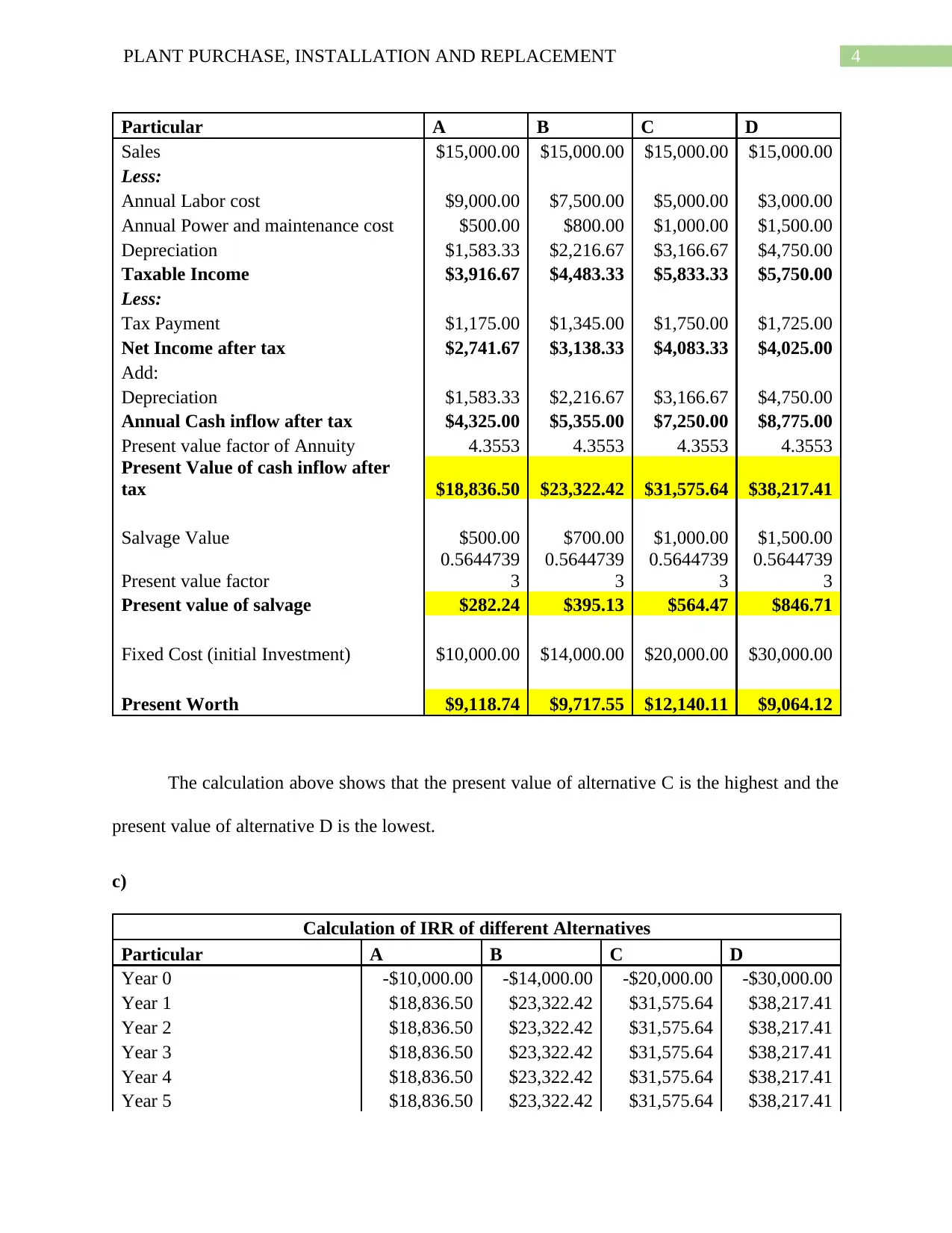
4PLANT PURCHASE, INSTALLATION AND REPLACEMENT
Particular A B C D
Sales $15,000.00 $15,000.00 $15,000.00 $15,000.00
Less:
Annual Labor cost $9,000.00 $7,500.00 $5,000.00 $3,000.00
Annual Power and maintenance cost $500.00 $800.00 $1,000.00 $1,500.00
Depreciation $1,583.33 $2,216.67 $3,166.67 $4,750.00
Taxable Income $3,916.67 $4,483.33 $5,833.33 $5,750.00
Less:
Tax Payment $1,175.00 $1,345.00 $1,750.00 $1,725.00
Net Income after tax $2,741.67 $3,138.33 $4,083.33 $4,025.00
Add:
Depreciation $1,583.33 $2,216.67 $3,166.67 $4,750.00
Annual Cash inflow after tax $4,325.00 $5,355.00 $7,250.00 $8,775.00
Present value factor of Annuity 4.3553 4.3553 4.3553 4.3553
Present Value of cash inflow after
tax $18,836.50 $23,322.42 $31,575.64 $38,217.41
Salvage Value $500.00 $700.00 $1,000.00 $1,500.00
Present value factor
0.5644739
3
0.5644739
3
0.5644739
3
0.5644739
3
Present value of salvage $282.24 $395.13 $564.47 $846.71
Fixed Cost (initial Investment) $10,000.00 $14,000.00 $20,000.00 $30,000.00
Present Worth $9,118.74 $9,717.55 $12,140.11 $9,064.12
The calculation above shows that the present value of alternative C is the highest and the
present value of alternative D is the lowest.
c)
Calculation of IRR of different Alternatives
Particular A B C D
Year 0 -$10,000.00 -$14,000.00 -$20,000.00 -$30,000.00
Year 1 $18,836.50 $23,322.42 $31,575.64 $38,217.41
Year 2 $18,836.50 $23,322.42 $31,575.64 $38,217.41
Year 3 $18,836.50 $23,322.42 $31,575.64 $38,217.41
Year 4 $18,836.50 $23,322.42 $31,575.64 $38,217.41
Year 5 $18,836.50 $23,322.42 $31,575.64 $38,217.41
Particular A B C D
Sales $15,000.00 $15,000.00 $15,000.00 $15,000.00
Less:
Annual Labor cost $9,000.00 $7,500.00 $5,000.00 $3,000.00
Annual Power and maintenance cost $500.00 $800.00 $1,000.00 $1,500.00
Depreciation $1,583.33 $2,216.67 $3,166.67 $4,750.00
Taxable Income $3,916.67 $4,483.33 $5,833.33 $5,750.00
Less:
Tax Payment $1,175.00 $1,345.00 $1,750.00 $1,725.00
Net Income after tax $2,741.67 $3,138.33 $4,083.33 $4,025.00
Add:
Depreciation $1,583.33 $2,216.67 $3,166.67 $4,750.00
Annual Cash inflow after tax $4,325.00 $5,355.00 $7,250.00 $8,775.00
Present value factor of Annuity 4.3553 4.3553 4.3553 4.3553
Present Value of cash inflow after
tax $18,836.50 $23,322.42 $31,575.64 $38,217.41
Salvage Value $500.00 $700.00 $1,000.00 $1,500.00
Present value factor
0.5644739
3
0.5644739
3
0.5644739
3
0.5644739
3
Present value of salvage $282.24 $395.13 $564.47 $846.71
Fixed Cost (initial Investment) $10,000.00 $14,000.00 $20,000.00 $30,000.00
Present Worth $9,118.74 $9,717.55 $12,140.11 $9,064.12
The calculation above shows that the present value of alternative C is the highest and the
present value of alternative D is the lowest.
c)
Calculation of IRR of different Alternatives
Particular A B C D
Year 0 -$10,000.00 -$14,000.00 -$20,000.00 -$30,000.00
Year 1 $18,836.50 $23,322.42 $31,575.64 $38,217.41
Year 2 $18,836.50 $23,322.42 $31,575.64 $38,217.41
Year 3 $18,836.50 $23,322.42 $31,575.64 $38,217.41
Year 4 $18,836.50 $23,322.42 $31,575.64 $38,217.41
Year 5 $18,836.50 $23,322.42 $31,575.64 $38,217.41
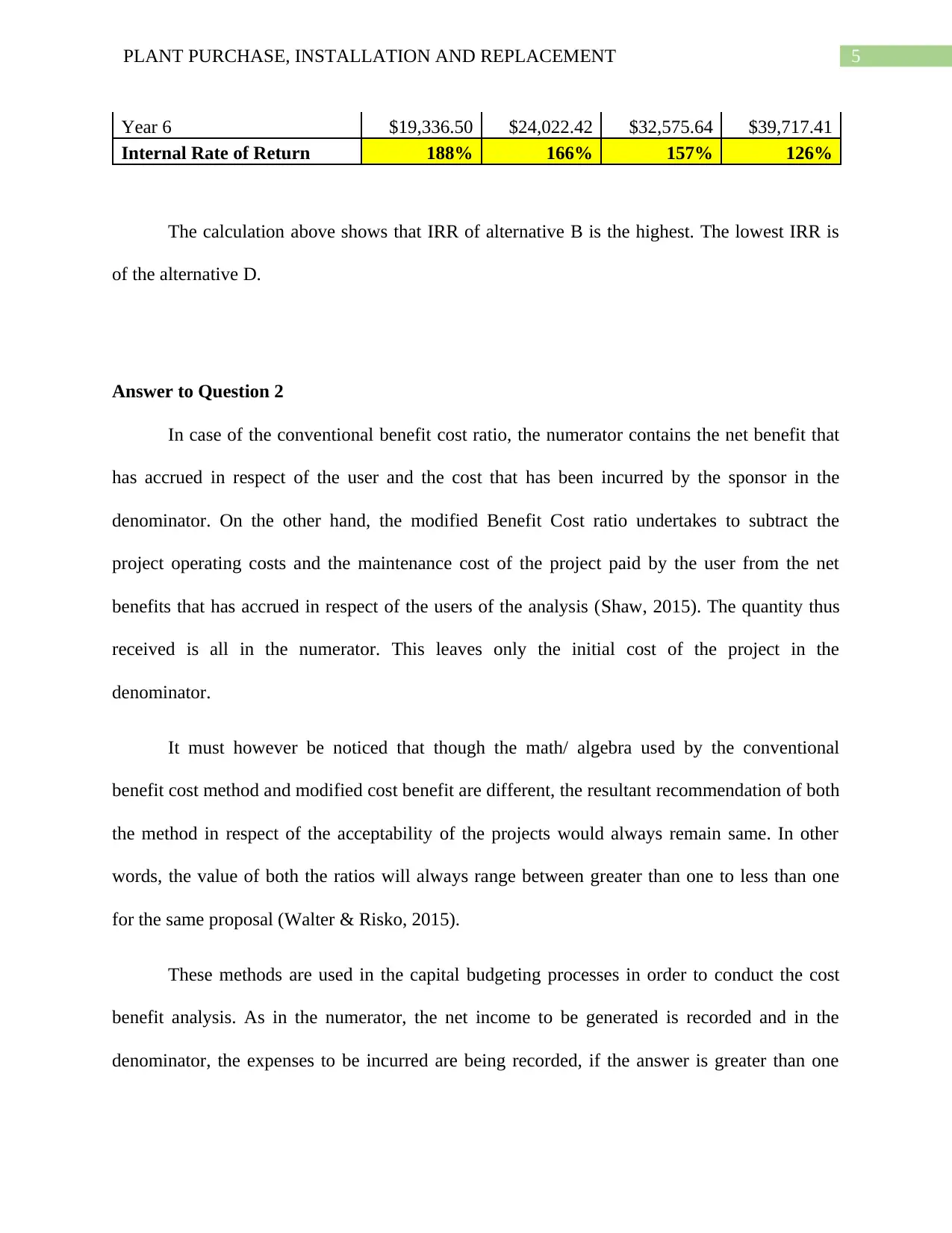
5PLANT PURCHASE, INSTALLATION AND REPLACEMENT
Year 6 $19,336.50 $24,022.42 $32,575.64 $39,717.41
Internal Rate of Return 188% 166% 157% 126%
The calculation above shows that IRR of alternative B is the highest. The lowest IRR is
of the alternative D.
Answer to Question 2
In case of the conventional benefit cost ratio, the numerator contains the net benefit that
has accrued in respect of the user and the cost that has been incurred by the sponsor in the
denominator. On the other hand, the modified Benefit Cost ratio undertakes to subtract the
project operating costs and the maintenance cost of the project paid by the user from the net
benefits that has accrued in respect of the users of the analysis (Shaw, 2015). The quantity thus
received is all in the numerator. This leaves only the initial cost of the project in the
denominator.
It must however be noticed that though the math/ algebra used by the conventional
benefit cost method and modified cost benefit are different, the resultant recommendation of both
the method in respect of the acceptability of the projects would always remain same. In other
words, the value of both the ratios will always range between greater than one to less than one
for the same proposal (Walter & Risko, 2015).
These methods are used in the capital budgeting processes in order to conduct the cost
benefit analysis. As in the numerator, the net income to be generated is recorded and in the
denominator, the expenses to be incurred are being recorded, if the answer is greater than one
Year 6 $19,336.50 $24,022.42 $32,575.64 $39,717.41
Internal Rate of Return 188% 166% 157% 126%
The calculation above shows that IRR of alternative B is the highest. The lowest IRR is
of the alternative D.
Answer to Question 2
In case of the conventional benefit cost ratio, the numerator contains the net benefit that
has accrued in respect of the user and the cost that has been incurred by the sponsor in the
denominator. On the other hand, the modified Benefit Cost ratio undertakes to subtract the
project operating costs and the maintenance cost of the project paid by the user from the net
benefits that has accrued in respect of the users of the analysis (Shaw, 2015). The quantity thus
received is all in the numerator. This leaves only the initial cost of the project in the
denominator.
It must however be noticed that though the math/ algebra used by the conventional
benefit cost method and modified cost benefit are different, the resultant recommendation of both
the method in respect of the acceptability of the projects would always remain same. In other
words, the value of both the ratios will always range between greater than one to less than one
for the same proposal (Walter & Risko, 2015).
These methods are used in the capital budgeting processes in order to conduct the cost
benefit analysis. As in the numerator, the net income to be generated is recorded and in the
denominator, the expenses to be incurred are being recorded, if the answer is greater than one
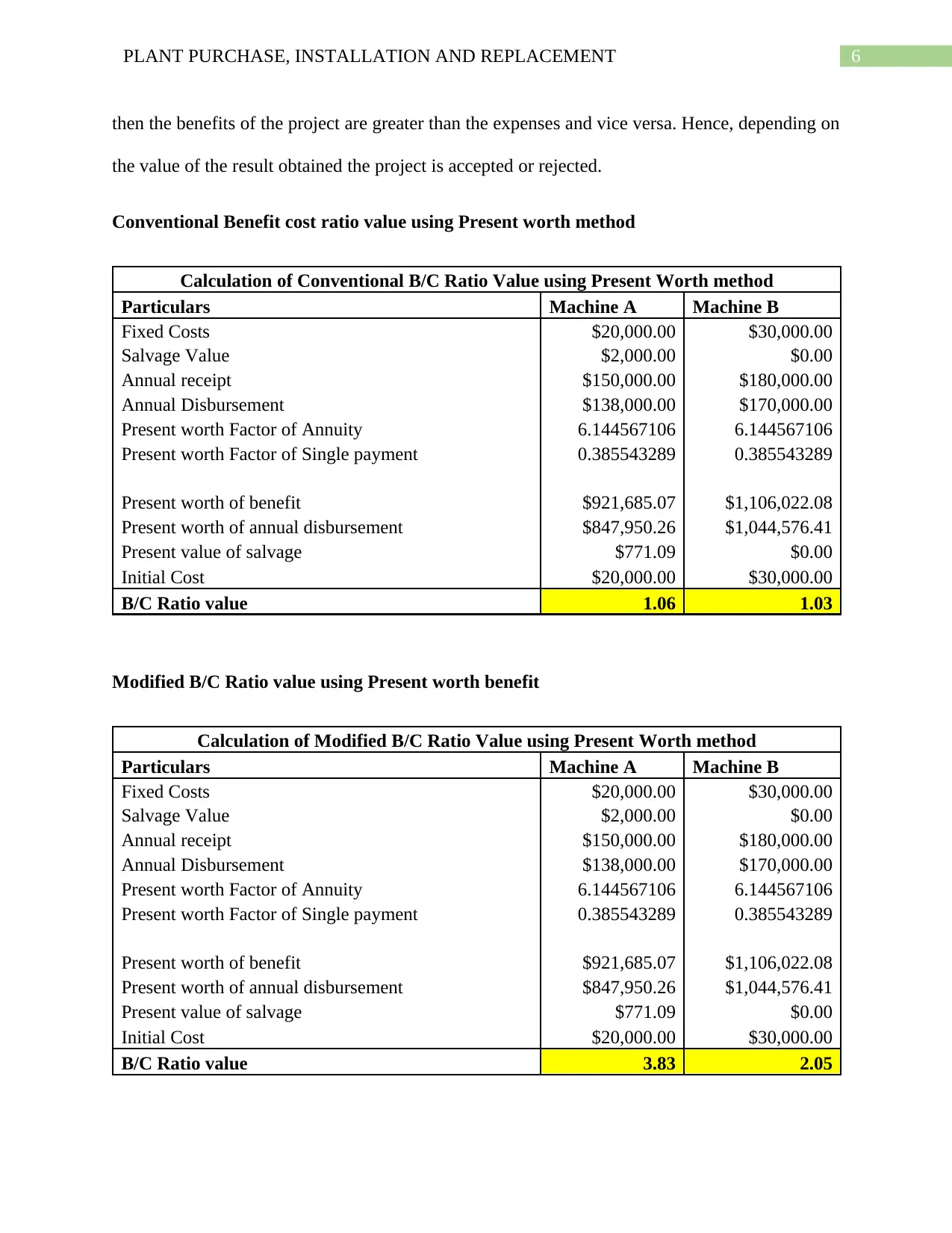
6PLANT PURCHASE, INSTALLATION AND REPLACEMENT
then the benefits of the project are greater than the expenses and vice versa. Hence, depending on
the value of the result obtained the project is accepted or rejected.
Conventional Benefit cost ratio value using Present worth method
Calculation of Conventional B/C Ratio Value using Present Worth method
Particulars Machine A Machine B
Fixed Costs $20,000.00 $30,000.00
Salvage Value $2,000.00 $0.00
Annual receipt $150,000.00 $180,000.00
Annual Disbursement $138,000.00 $170,000.00
Present worth Factor of Annuity 6.144567106 6.144567106
Present worth Factor of Single payment 0.385543289 0.385543289
Present worth of benefit $921,685.07 $1,106,022.08
Present worth of annual disbursement $847,950.26 $1,044,576.41
Present value of salvage $771.09 $0.00
Initial Cost $20,000.00 $30,000.00
B/C Ratio value 1.06 1.03
Modified B/C Ratio value using Present worth benefit
Calculation of Modified B/C Ratio Value using Present Worth method
Particulars Machine A Machine B
Fixed Costs $20,000.00 $30,000.00
Salvage Value $2,000.00 $0.00
Annual receipt $150,000.00 $180,000.00
Annual Disbursement $138,000.00 $170,000.00
Present worth Factor of Annuity 6.144567106 6.144567106
Present worth Factor of Single payment 0.385543289 0.385543289
Present worth of benefit $921,685.07 $1,106,022.08
Present worth of annual disbursement $847,950.26 $1,044,576.41
Present value of salvage $771.09 $0.00
Initial Cost $20,000.00 $30,000.00
B/C Ratio value 3.83 2.05
then the benefits of the project are greater than the expenses and vice versa. Hence, depending on
the value of the result obtained the project is accepted or rejected.
Conventional Benefit cost ratio value using Present worth method
Calculation of Conventional B/C Ratio Value using Present Worth method
Particulars Machine A Machine B
Fixed Costs $20,000.00 $30,000.00
Salvage Value $2,000.00 $0.00
Annual receipt $150,000.00 $180,000.00
Annual Disbursement $138,000.00 $170,000.00
Present worth Factor of Annuity 6.144567106 6.144567106
Present worth Factor of Single payment 0.385543289 0.385543289
Present worth of benefit $921,685.07 $1,106,022.08
Present worth of annual disbursement $847,950.26 $1,044,576.41
Present value of salvage $771.09 $0.00
Initial Cost $20,000.00 $30,000.00
B/C Ratio value 1.06 1.03
Modified B/C Ratio value using Present worth benefit
Calculation of Modified B/C Ratio Value using Present Worth method
Particulars Machine A Machine B
Fixed Costs $20,000.00 $30,000.00
Salvage Value $2,000.00 $0.00
Annual receipt $150,000.00 $180,000.00
Annual Disbursement $138,000.00 $170,000.00
Present worth Factor of Annuity 6.144567106 6.144567106
Present worth Factor of Single payment 0.385543289 0.385543289
Present worth of benefit $921,685.07 $1,106,022.08
Present worth of annual disbursement $847,950.26 $1,044,576.41
Present value of salvage $771.09 $0.00
Initial Cost $20,000.00 $30,000.00
B/C Ratio value 3.83 2.05
Paraphrase This Document
Need a fresh take? Get an instant paraphrase of this document with our AI Paraphraser
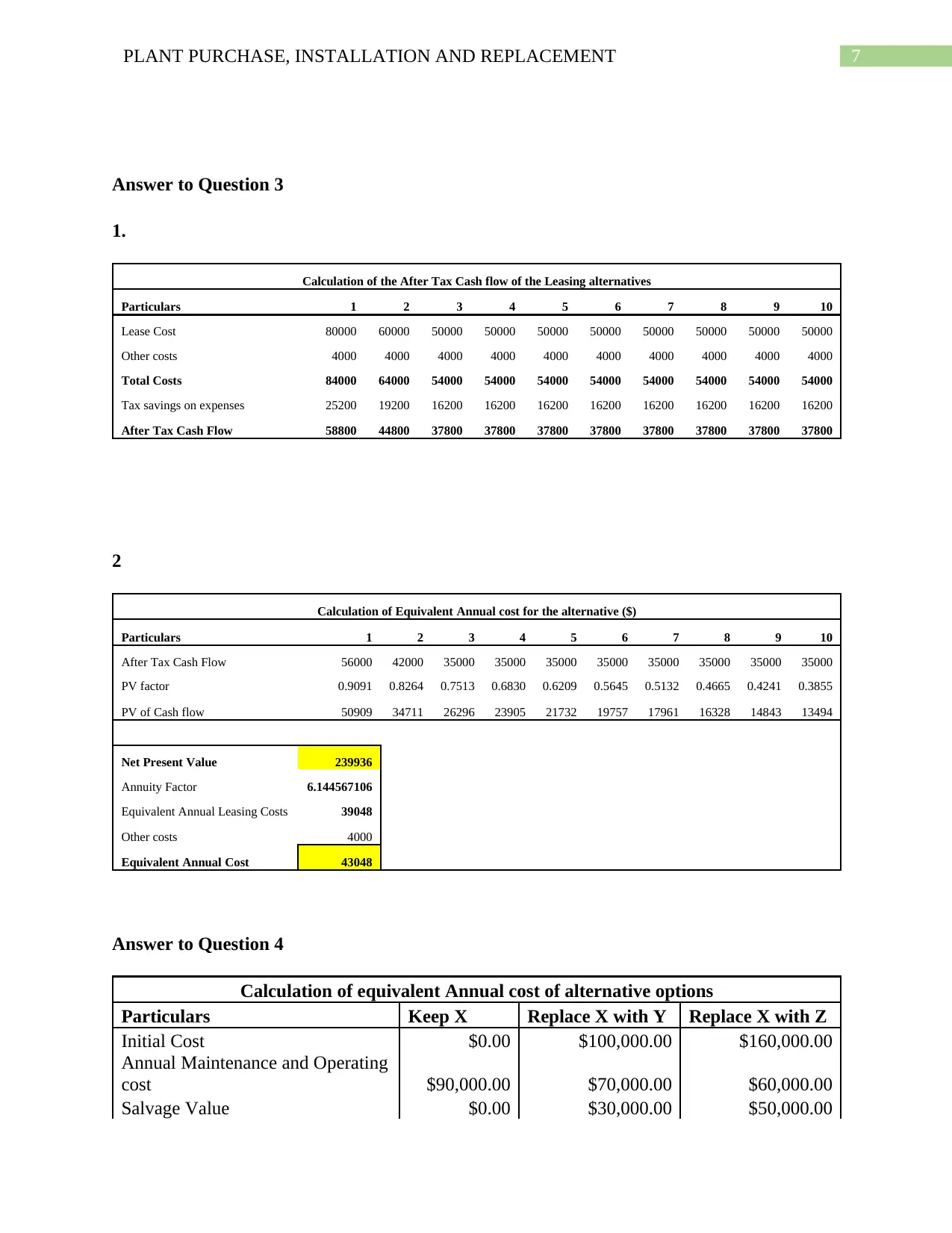
7PLANT PURCHASE, INSTALLATION AND REPLACEMENT
Answer to Question 3
1.
Calculation of the After Tax Cash flow of the Leasing alternatives
Particulars 1 2 3 4 5 6 7 8 9 10
Lease Cost 80000 60000 50000 50000 50000 50000 50000 50000 50000 50000
Other costs 4000 4000 4000 4000 4000 4000 4000 4000 4000 4000
Total Costs 84000 64000 54000 54000 54000 54000 54000 54000 54000 54000
Tax savings on expenses 25200 19200 16200 16200 16200 16200 16200 16200 16200 16200
After Tax Cash Flow 58800 44800 37800 37800 37800 37800 37800 37800 37800 37800
2
Calculation of Equivalent Annual cost for the alternative ($)
Particulars 1 2 3 4 5 6 7 8 9 10
After Tax Cash Flow 56000 42000 35000 35000 35000 35000 35000 35000 35000 35000
PV factor 0.9091 0.8264 0.7513 0.6830 0.6209 0.5645 0.5132 0.4665 0.4241 0.3855
PV of Cash flow 50909 34711 26296 23905 21732 19757 17961 16328 14843 13494
Net Present Value 239936
Annuity Factor 6.144567106
Equivalent Annual Leasing Costs 39048
Other costs 4000
Equivalent Annual Cost 43048
Answer to Question 4
Calculation of equivalent Annual cost of alternative options
Particulars Keep X Replace X with Y Replace X with Z
Initial Cost $0.00 $100,000.00 $160,000.00
Annual Maintenance and Operating
cost $90,000.00 $70,000.00 $60,000.00
Salvage Value $0.00 $30,000.00 $50,000.00
Answer to Question 3
1.
Calculation of the After Tax Cash flow of the Leasing alternatives
Particulars 1 2 3 4 5 6 7 8 9 10
Lease Cost 80000 60000 50000 50000 50000 50000 50000 50000 50000 50000
Other costs 4000 4000 4000 4000 4000 4000 4000 4000 4000 4000
Total Costs 84000 64000 54000 54000 54000 54000 54000 54000 54000 54000
Tax savings on expenses 25200 19200 16200 16200 16200 16200 16200 16200 16200 16200
After Tax Cash Flow 58800 44800 37800 37800 37800 37800 37800 37800 37800 37800
2
Calculation of Equivalent Annual cost for the alternative ($)
Particulars 1 2 3 4 5 6 7 8 9 10
After Tax Cash Flow 56000 42000 35000 35000 35000 35000 35000 35000 35000 35000
PV factor 0.9091 0.8264 0.7513 0.6830 0.6209 0.5645 0.5132 0.4665 0.4241 0.3855
PV of Cash flow 50909 34711 26296 23905 21732 19757 17961 16328 14843 13494
Net Present Value 239936
Annuity Factor 6.144567106
Equivalent Annual Leasing Costs 39048
Other costs 4000
Equivalent Annual Cost 43048
Answer to Question 4
Calculation of equivalent Annual cost of alternative options
Particulars Keep X Replace X with Y Replace X with Z
Initial Cost $0.00 $100,000.00 $160,000.00
Annual Maintenance and Operating
cost $90,000.00 $70,000.00 $60,000.00
Salvage Value $0.00 $30,000.00 $50,000.00
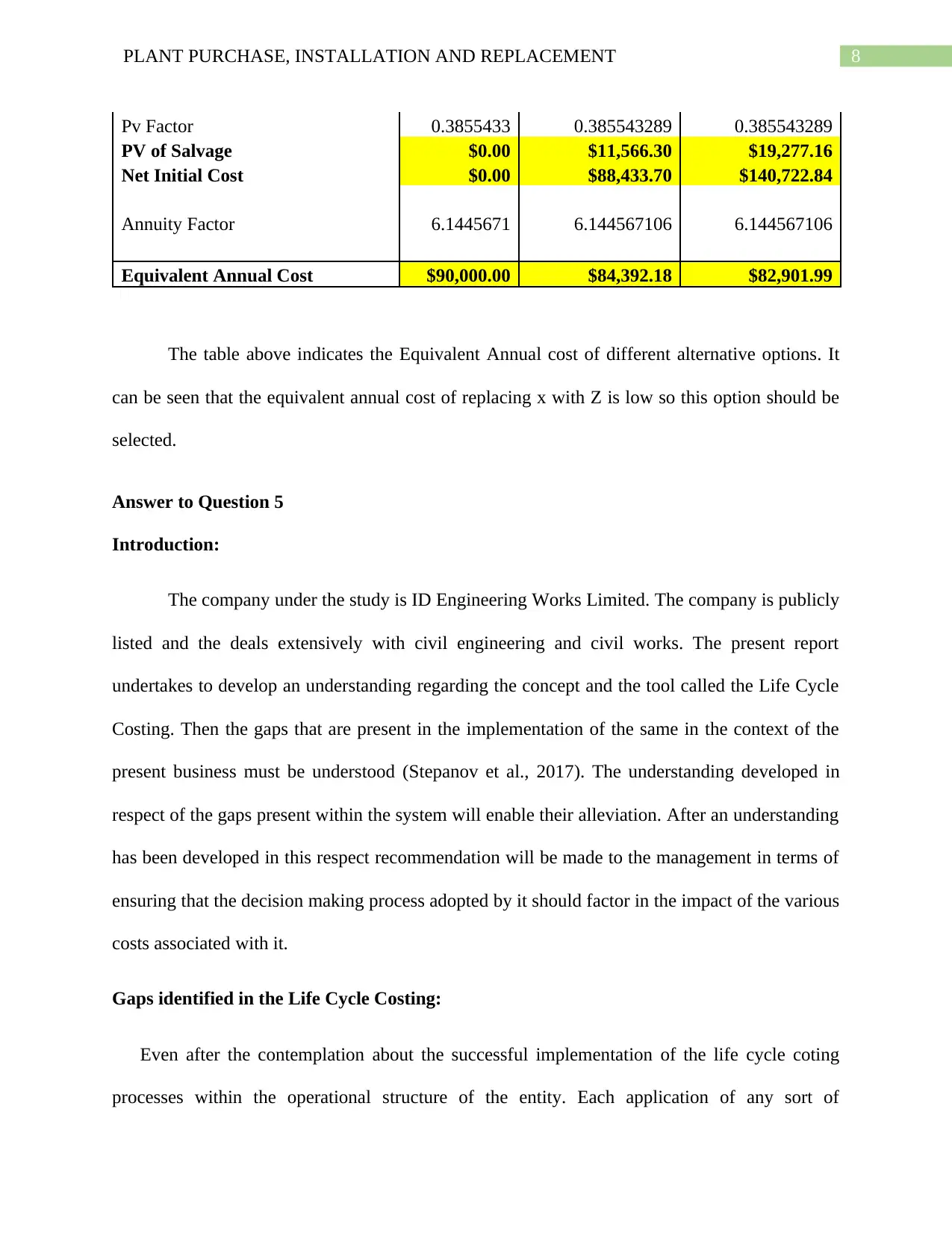
8PLANT PURCHASE, INSTALLATION AND REPLACEMENT
Pv Factor 0.3855433 0.385543289 0.385543289
PV of Salvage $0.00 $11,566.30 $19,277.16
Net Initial Cost $0.00 $88,433.70 $140,722.84
Annuity Factor 6.1445671 6.144567106 6.144567106
Equivalent Annual Cost $90,000.00 $84,392.18 $82,901.99
The table above indicates the Equivalent Annual cost of different alternative options. It
can be seen that the equivalent annual cost of replacing x with Z is low so this option should be
selected.
Answer to Question 5
Introduction:
The company under the study is ID Engineering Works Limited. The company is publicly
listed and the deals extensively with civil engineering and civil works. The present report
undertakes to develop an understanding regarding the concept and the tool called the Life Cycle
Costing. Then the gaps that are present in the implementation of the same in the context of the
present business must be understood (Stepanov et al., 2017). The understanding developed in
respect of the gaps present within the system will enable their alleviation. After an understanding
has been developed in this respect recommendation will be made to the management in terms of
ensuring that the decision making process adopted by it should factor in the impact of the various
costs associated with it.
Gaps identified in the Life Cycle Costing:
Even after the contemplation about the successful implementation of the life cycle coting
processes within the operational structure of the entity. Each application of any sort of
Pv Factor 0.3855433 0.385543289 0.385543289
PV of Salvage $0.00 $11,566.30 $19,277.16
Net Initial Cost $0.00 $88,433.70 $140,722.84
Annuity Factor 6.1445671 6.144567106 6.144567106
Equivalent Annual Cost $90,000.00 $84,392.18 $82,901.99
The table above indicates the Equivalent Annual cost of different alternative options. It
can be seen that the equivalent annual cost of replacing x with Z is low so this option should be
selected.
Answer to Question 5
Introduction:
The company under the study is ID Engineering Works Limited. The company is publicly
listed and the deals extensively with civil engineering and civil works. The present report
undertakes to develop an understanding regarding the concept and the tool called the Life Cycle
Costing. Then the gaps that are present in the implementation of the same in the context of the
present business must be understood (Stepanov et al., 2017). The understanding developed in
respect of the gaps present within the system will enable their alleviation. After an understanding
has been developed in this respect recommendation will be made to the management in terms of
ensuring that the decision making process adopted by it should factor in the impact of the various
costs associated with it.
Gaps identified in the Life Cycle Costing:
Even after the contemplation about the successful implementation of the life cycle coting
processes within the operational structure of the entity. Each application of any sort of
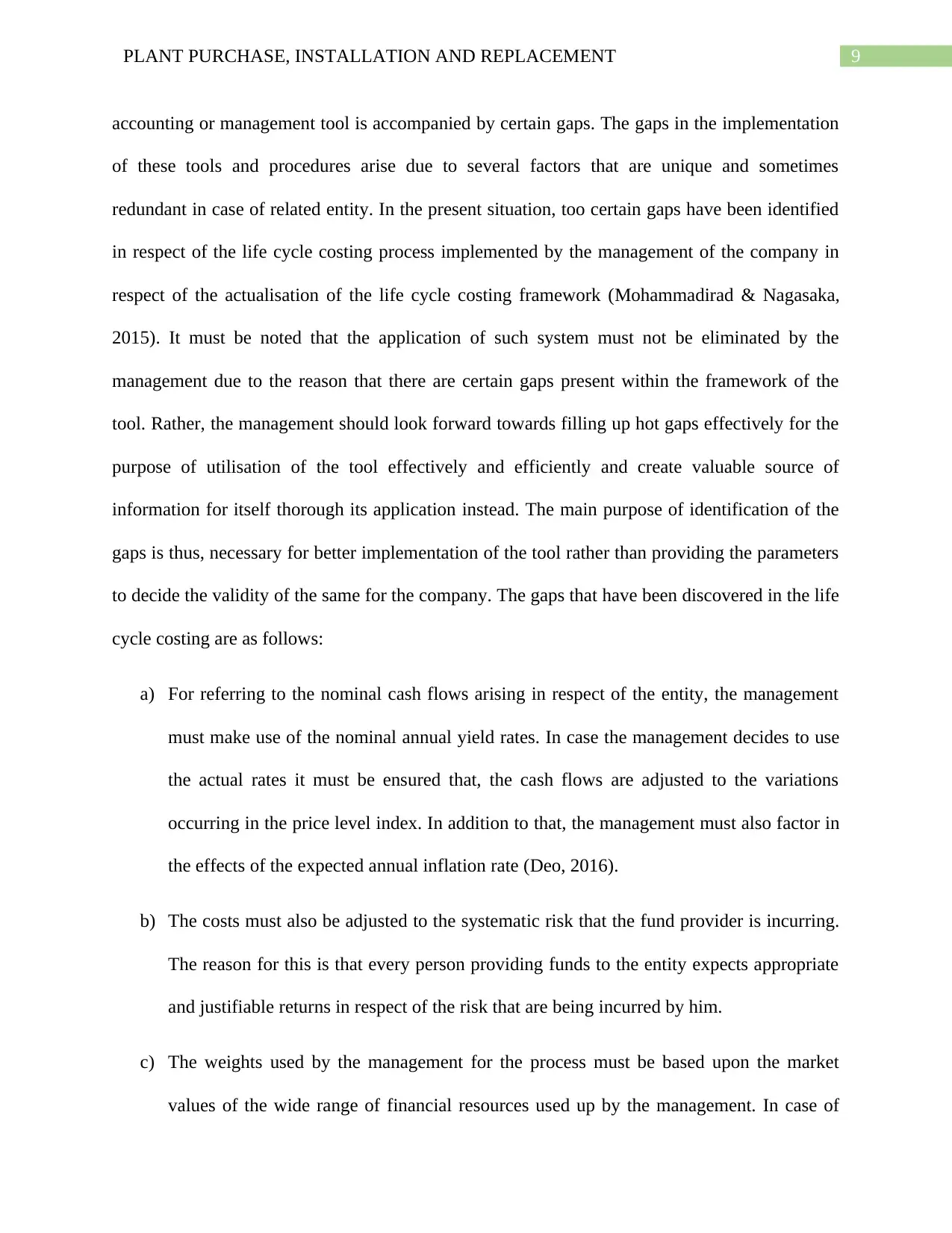
9PLANT PURCHASE, INSTALLATION AND REPLACEMENT
accounting or management tool is accompanied by certain gaps. The gaps in the implementation
of these tools and procedures arise due to several factors that are unique and sometimes
redundant in case of related entity. In the present situation, too certain gaps have been identified
in respect of the life cycle costing process implemented by the management of the company in
respect of the actualisation of the life cycle costing framework (Mohammadirad & Nagasaka,
2015). It must be noted that the application of such system must not be eliminated by the
management due to the reason that there are certain gaps present within the framework of the
tool. Rather, the management should look forward towards filling up hot gaps effectively for the
purpose of utilisation of the tool effectively and efficiently and create valuable source of
information for itself thorough its application instead. The main purpose of identification of the
gaps is thus, necessary for better implementation of the tool rather than providing the parameters
to decide the validity of the same for the company. The gaps that have been discovered in the life
cycle costing are as follows:
a) For referring to the nominal cash flows arising in respect of the entity, the management
must make use of the nominal annual yield rates. In case the management decides to use
the actual rates it must be ensured that, the cash flows are adjusted to the variations
occurring in the price level index. In addition to that, the management must also factor in
the effects of the expected annual inflation rate (Deo, 2016).
b) The costs must also be adjusted to the systematic risk that the fund provider is incurring.
The reason for this is that every person providing funds to the entity expects appropriate
and justifiable returns in respect of the risk that are being incurred by him.
c) The weights used by the management for the process must be based upon the market
values of the wide range of financial resources used up by the management. In case of
accounting or management tool is accompanied by certain gaps. The gaps in the implementation
of these tools and procedures arise due to several factors that are unique and sometimes
redundant in case of related entity. In the present situation, too certain gaps have been identified
in respect of the life cycle costing process implemented by the management of the company in
respect of the actualisation of the life cycle costing framework (Mohammadirad & Nagasaka,
2015). It must be noted that the application of such system must not be eliminated by the
management due to the reason that there are certain gaps present within the framework of the
tool. Rather, the management should look forward towards filling up hot gaps effectively for the
purpose of utilisation of the tool effectively and efficiently and create valuable source of
information for itself thorough its application instead. The main purpose of identification of the
gaps is thus, necessary for better implementation of the tool rather than providing the parameters
to decide the validity of the same for the company. The gaps that have been discovered in the life
cycle costing are as follows:
a) For referring to the nominal cash flows arising in respect of the entity, the management
must make use of the nominal annual yield rates. In case the management decides to use
the actual rates it must be ensured that, the cash flows are adjusted to the variations
occurring in the price level index. In addition to that, the management must also factor in
the effects of the expected annual inflation rate (Deo, 2016).
b) The costs must also be adjusted to the systematic risk that the fund provider is incurring.
The reason for this is that every person providing funds to the entity expects appropriate
and justifiable returns in respect of the risk that are being incurred by him.
c) The weights used by the management for the process must be based upon the market
values of the wide range of financial resources used up by the management. In case of
Secure Best Marks with AI Grader
Need help grading? Try our AI Grader for instant feedback on your assignments.
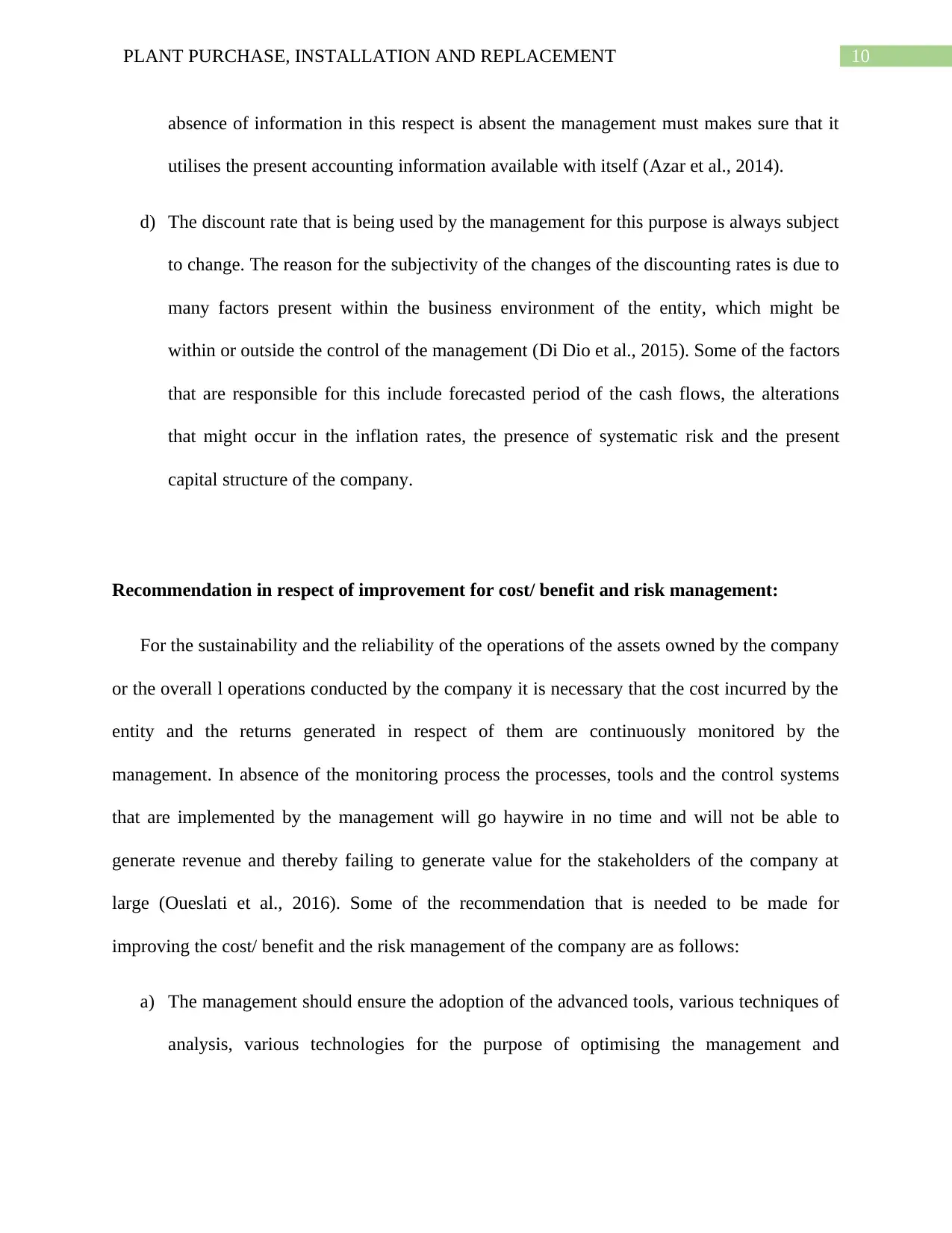
10PLANT PURCHASE, INSTALLATION AND REPLACEMENT
absence of information in this respect is absent the management must makes sure that it
utilises the present accounting information available with itself (Azar et al., 2014).
d) The discount rate that is being used by the management for this purpose is always subject
to change. The reason for the subjectivity of the changes of the discounting rates is due to
many factors present within the business environment of the entity, which might be
within or outside the control of the management (Di Dio et al., 2015). Some of the factors
that are responsible for this include forecasted period of the cash flows, the alterations
that might occur in the inflation rates, the presence of systematic risk and the present
capital structure of the company.
Recommendation in respect of improvement for cost/ benefit and risk management:
For the sustainability and the reliability of the operations of the assets owned by the company
or the overall l operations conducted by the company it is necessary that the cost incurred by the
entity and the returns generated in respect of them are continuously monitored by the
management. In absence of the monitoring process the processes, tools and the control systems
that are implemented by the management will go haywire in no time and will not be able to
generate revenue and thereby failing to generate value for the stakeholders of the company at
large (Oueslati et al., 2016). Some of the recommendation that is needed to be made for
improving the cost/ benefit and the risk management of the company are as follows:
a) The management should ensure the adoption of the advanced tools, various techniques of
analysis, various technologies for the purpose of optimising the management and
absence of information in this respect is absent the management must makes sure that it
utilises the present accounting information available with itself (Azar et al., 2014).
d) The discount rate that is being used by the management for this purpose is always subject
to change. The reason for the subjectivity of the changes of the discounting rates is due to
many factors present within the business environment of the entity, which might be
within or outside the control of the management (Di Dio et al., 2015). Some of the factors
that are responsible for this include forecasted period of the cash flows, the alterations
that might occur in the inflation rates, the presence of systematic risk and the present
capital structure of the company.
Recommendation in respect of improvement for cost/ benefit and risk management:
For the sustainability and the reliability of the operations of the assets owned by the company
or the overall l operations conducted by the company it is necessary that the cost incurred by the
entity and the returns generated in respect of them are continuously monitored by the
management. In absence of the monitoring process the processes, tools and the control systems
that are implemented by the management will go haywire in no time and will not be able to
generate revenue and thereby failing to generate value for the stakeholders of the company at
large (Oueslati et al., 2016). Some of the recommendation that is needed to be made for
improving the cost/ benefit and the risk management of the company are as follows:
a) The management should ensure the adoption of the advanced tools, various techniques of
analysis, various technologies for the purpose of optimising the management and
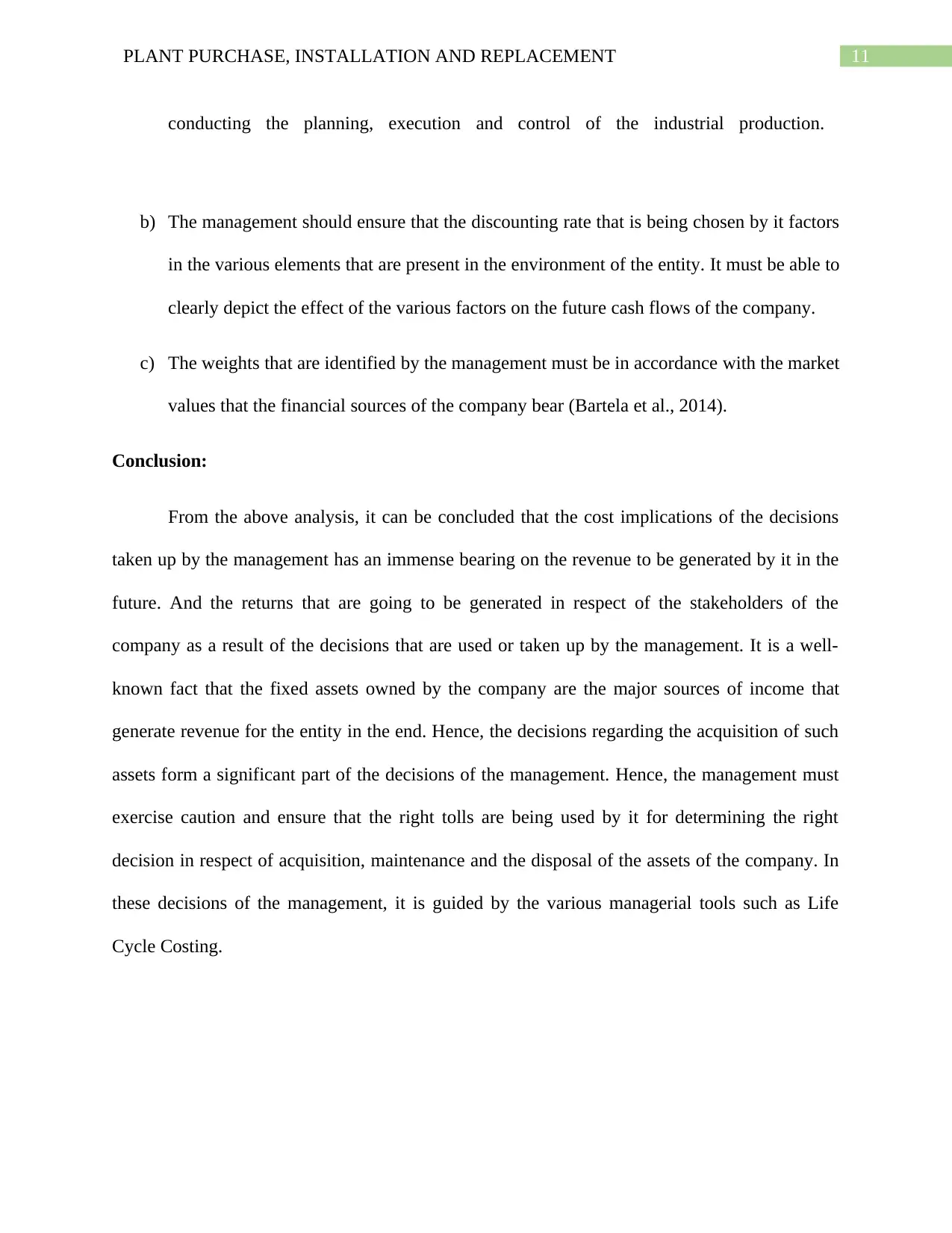
11PLANT PURCHASE, INSTALLATION AND REPLACEMENT
conducting the planning, execution and control of the industrial production.
b) The management should ensure that the discounting rate that is being chosen by it factors
in the various elements that are present in the environment of the entity. It must be able to
clearly depict the effect of the various factors on the future cash flows of the company.
c) The weights that are identified by the management must be in accordance with the market
values that the financial sources of the company bear (Bartela et al., 2014).
Conclusion:
From the above analysis, it can be concluded that the cost implications of the decisions
taken up by the management has an immense bearing on the revenue to be generated by it in the
future. And the returns that are going to be generated in respect of the stakeholders of the
company as a result of the decisions that are used or taken up by the management. It is a well-
known fact that the fixed assets owned by the company are the major sources of income that
generate revenue for the entity in the end. Hence, the decisions regarding the acquisition of such
assets form a significant part of the decisions of the management. Hence, the management must
exercise caution and ensure that the right tolls are being used by it for determining the right
decision in respect of acquisition, maintenance and the disposal of the assets of the company. In
these decisions of the management, it is guided by the various managerial tools such as Life
Cycle Costing.
conducting the planning, execution and control of the industrial production.
b) The management should ensure that the discounting rate that is being chosen by it factors
in the various elements that are present in the environment of the entity. It must be able to
clearly depict the effect of the various factors on the future cash flows of the company.
c) The weights that are identified by the management must be in accordance with the market
values that the financial sources of the company bear (Bartela et al., 2014).
Conclusion:
From the above analysis, it can be concluded that the cost implications of the decisions
taken up by the management has an immense bearing on the revenue to be generated by it in the
future. And the returns that are going to be generated in respect of the stakeholders of the
company as a result of the decisions that are used or taken up by the management. It is a well-
known fact that the fixed assets owned by the company are the major sources of income that
generate revenue for the entity in the end. Hence, the decisions regarding the acquisition of such
assets form a significant part of the decisions of the management. Hence, the management must
exercise caution and ensure that the right tolls are being used by it for determining the right
decision in respect of acquisition, maintenance and the disposal of the assets of the company. In
these decisions of the management, it is guided by the various managerial tools such as Life
Cycle Costing.

12PLANT PURCHASE, INSTALLATION AND REPLACEMENT
Paraphrase This Document
Need a fresh take? Get an instant paraphrase of this document with our AI Paraphraser
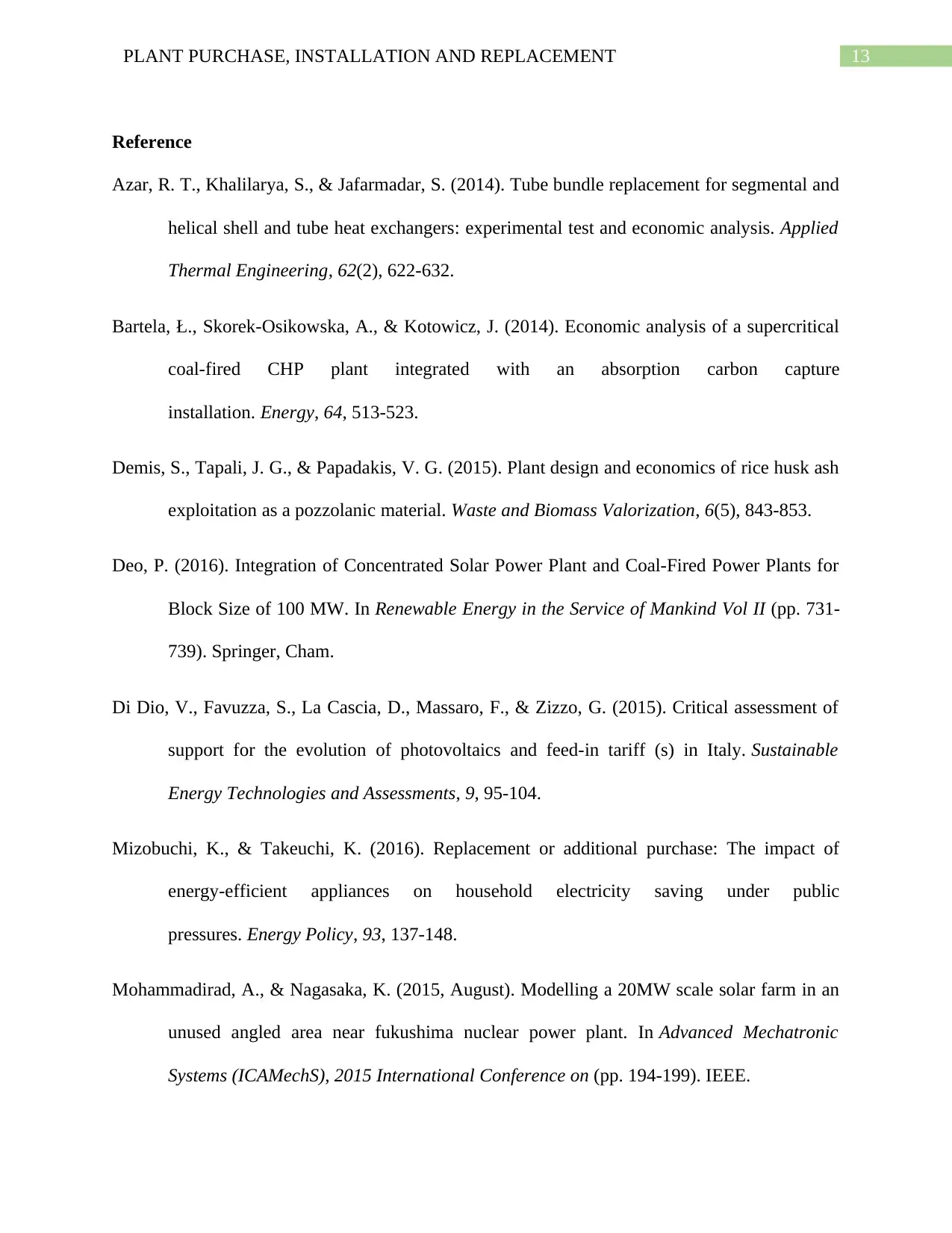
13PLANT PURCHASE, INSTALLATION AND REPLACEMENT
Reference
Azar, R. T., Khalilarya, S., & Jafarmadar, S. (2014). Tube bundle replacement for segmental and
helical shell and tube heat exchangers: experimental test and economic analysis. Applied
Thermal Engineering, 62(2), 622-632.
Bartela, Ł., Skorek-Osikowska, A., & Kotowicz, J. (2014). Economic analysis of a supercritical
coal-fired CHP plant integrated with an absorption carbon capture
installation. Energy, 64, 513-523.
Demis, S., Tapali, J. G., & Papadakis, V. G. (2015). Plant design and economics of rice husk ash
exploitation as a pozzolanic material. Waste and Biomass Valorization, 6(5), 843-853.
Deo, P. (2016). Integration of Concentrated Solar Power Plant and Coal-Fired Power Plants for
Block Size of 100 MW. In Renewable Energy in the Service of Mankind Vol II (pp. 731-
739). Springer, Cham.
Di Dio, V., Favuzza, S., La Cascia, D., Massaro, F., & Zizzo, G. (2015). Critical assessment of
support for the evolution of photovoltaics and feed-in tariff (s) in Italy. Sustainable
Energy Technologies and Assessments, 9, 95-104.
Mizobuchi, K., & Takeuchi, K. (2016). Replacement or additional purchase: The impact of
energy-efficient appliances on household electricity saving under public
pressures. Energy Policy, 93, 137-148.
Mohammadirad, A., & Nagasaka, K. (2015, August). Modelling a 20MW scale solar farm in an
unused angled area near fukushima nuclear power plant. In Advanced Mechatronic
Systems (ICAMechS), 2015 International Conference on (pp. 194-199). IEEE.
Reference
Azar, R. T., Khalilarya, S., & Jafarmadar, S. (2014). Tube bundle replacement for segmental and
helical shell and tube heat exchangers: experimental test and economic analysis. Applied
Thermal Engineering, 62(2), 622-632.
Bartela, Ł., Skorek-Osikowska, A., & Kotowicz, J. (2014). Economic analysis of a supercritical
coal-fired CHP plant integrated with an absorption carbon capture
installation. Energy, 64, 513-523.
Demis, S., Tapali, J. G., & Papadakis, V. G. (2015). Plant design and economics of rice husk ash
exploitation as a pozzolanic material. Waste and Biomass Valorization, 6(5), 843-853.
Deo, P. (2016). Integration of Concentrated Solar Power Plant and Coal-Fired Power Plants for
Block Size of 100 MW. In Renewable Energy in the Service of Mankind Vol II (pp. 731-
739). Springer, Cham.
Di Dio, V., Favuzza, S., La Cascia, D., Massaro, F., & Zizzo, G. (2015). Critical assessment of
support for the evolution of photovoltaics and feed-in tariff (s) in Italy. Sustainable
Energy Technologies and Assessments, 9, 95-104.
Mizobuchi, K., & Takeuchi, K. (2016). Replacement or additional purchase: The impact of
energy-efficient appliances on household electricity saving under public
pressures. Energy Policy, 93, 137-148.
Mohammadirad, A., & Nagasaka, K. (2015, August). Modelling a 20MW scale solar farm in an
unused angled area near fukushima nuclear power plant. In Advanced Mechatronic
Systems (ICAMechS), 2015 International Conference on (pp. 194-199). IEEE.
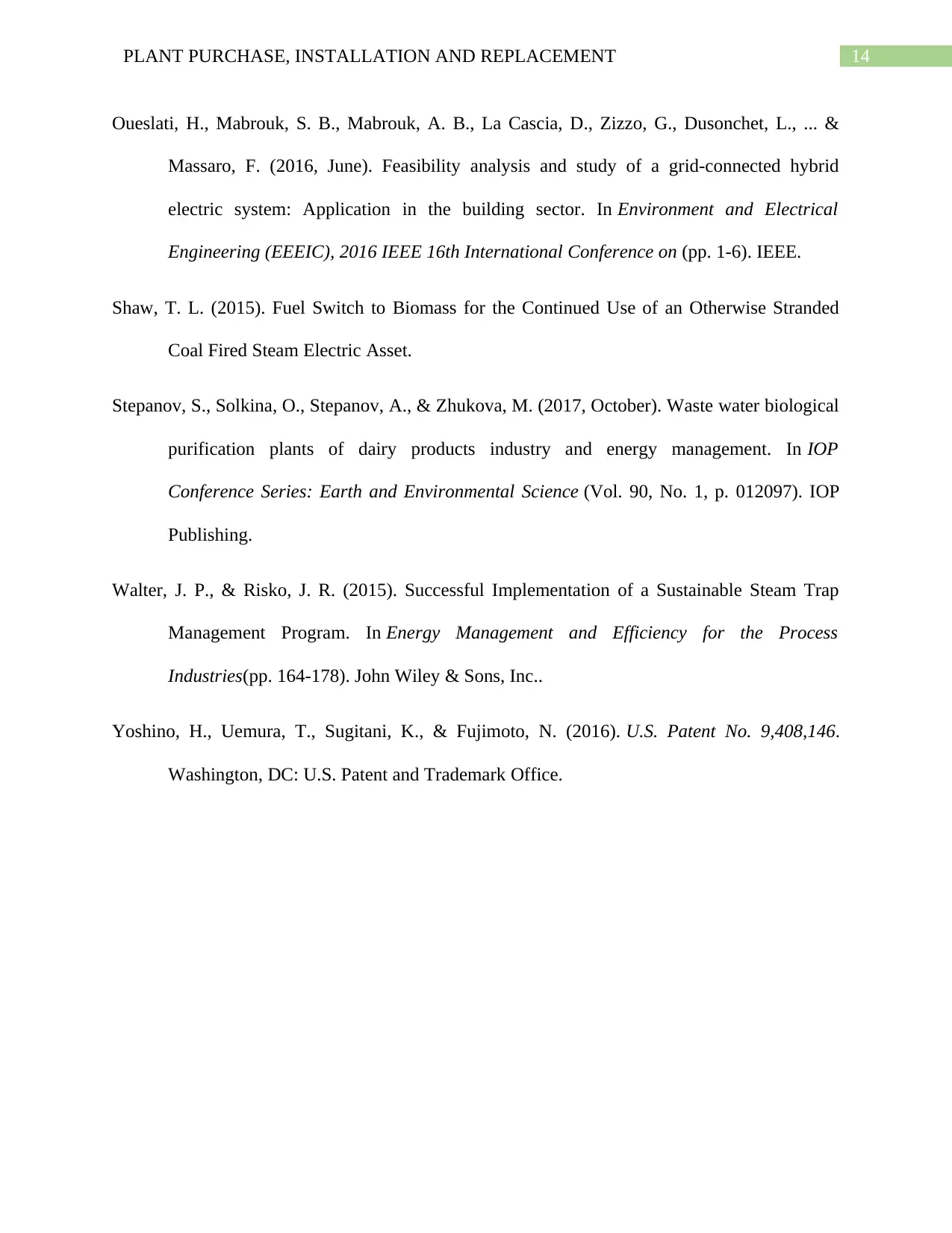
14PLANT PURCHASE, INSTALLATION AND REPLACEMENT
Oueslati, H., Mabrouk, S. B., Mabrouk, A. B., La Cascia, D., Zizzo, G., Dusonchet, L., ... &
Massaro, F. (2016, June). Feasibility analysis and study of a grid-connected hybrid
electric system: Application in the building sector. In Environment and Electrical
Engineering (EEEIC), 2016 IEEE 16th International Conference on (pp. 1-6). IEEE.
Shaw, T. L. (2015). Fuel Switch to Biomass for the Continued Use of an Otherwise Stranded
Coal Fired Steam Electric Asset.
Stepanov, S., Solkina, O., Stepanov, A., & Zhukova, M. (2017, October). Waste water biological
purification plants of dairy products industry and energy management. In IOP
Conference Series: Earth and Environmental Science (Vol. 90, No. 1, p. 012097). IOP
Publishing.
Walter, J. P., & Risko, J. R. (2015). Successful Implementation of a Sustainable Steam Trap
Management Program. In Energy Management and Efficiency for the Process
Industries(pp. 164-178). John Wiley & Sons, Inc..
Yoshino, H., Uemura, T., Sugitani, K., & Fujimoto, N. (2016). U.S. Patent No. 9,408,146.
Washington, DC: U.S. Patent and Trademark Office.
Oueslati, H., Mabrouk, S. B., Mabrouk, A. B., La Cascia, D., Zizzo, G., Dusonchet, L., ... &
Massaro, F. (2016, June). Feasibility analysis and study of a grid-connected hybrid
electric system: Application in the building sector. In Environment and Electrical
Engineering (EEEIC), 2016 IEEE 16th International Conference on (pp. 1-6). IEEE.
Shaw, T. L. (2015). Fuel Switch to Biomass for the Continued Use of an Otherwise Stranded
Coal Fired Steam Electric Asset.
Stepanov, S., Solkina, O., Stepanov, A., & Zhukova, M. (2017, October). Waste water biological
purification plants of dairy products industry and energy management. In IOP
Conference Series: Earth and Environmental Science (Vol. 90, No. 1, p. 012097). IOP
Publishing.
Walter, J. P., & Risko, J. R. (2015). Successful Implementation of a Sustainable Steam Trap
Management Program. In Energy Management and Efficiency for the Process
Industries(pp. 164-178). John Wiley & Sons, Inc..
Yoshino, H., Uemura, T., Sugitani, K., & Fujimoto, N. (2016). U.S. Patent No. 9,408,146.
Washington, DC: U.S. Patent and Trademark Office.

15PLANT PURCHASE, INSTALLATION AND REPLACEMENT
1 out of 16
Related Documents
Your All-in-One AI-Powered Toolkit for Academic Success.
+13062052269
info@desklib.com
Available 24*7 on WhatsApp / Email
![[object Object]](/_next/static/media/star-bottom.7253800d.svg)
Unlock your academic potential
© 2024 | Zucol Services PVT LTD | All rights reserved.





